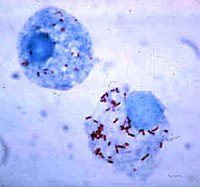
Photo from wikipedia
Orientia tsutsugamushi (Ott) is a causative agent of scrub typhus, and one of the emerging pathogens that could affect a large human population. It is one of the misdiagnosed and… Click to show full abstract
Orientia tsutsugamushi (Ott) is a causative agent of scrub typhus, and one of the emerging pathogens that could affect a large human population. It is one of the misdiagnosed and under-reported, febrile illnesses that infects various body organs (skin, heart, lung, kidney, and brain). The control of this infection is hampered due to the lack of drugs or vaccine against it. This study was undertaken to identify potential drug targets from the core genome of Ott and investigate novel natural product inhibitors against them. Hence, the available genomes for 22 strains of Ott were downloaded from the PATRIC database, and pan-genomic analysis was performed. Only 202 genes were present in the core region. Among these, 94 were identified as essential, 32 non-homologous to humans, nine non-homologous to useful gut flora and a single gene dapD as a drug target. Product of this gene (2,3,4,5-tetrahydropyridine-2-carboxylate N-succinyltransferase) was modeled and docked against traditional Indian (Ayurvedic) and Chinese phytochemical libraries, with best hits selected for docking, based on multiple target-drug/s interactions and minimum energy scores. ADMET profiling and molecular dynamics simulation was performed for top three compounds from each library to assess the toxicity and stability, respectively. We presume that these compounds (ZINC8214635, ZINC32793028, ZINC08101133, ZINC85625167, ZINC06018678, and ZINC13377938) could be successful inhibitors of Ott. However, in-depth experimental and clinical research is needed for further validation.
Journal Title: Computers in biology and medicine
Year Published: 2022
Link to full text (if available)
Share on Social Media: Sign Up to like & get
recommendations!